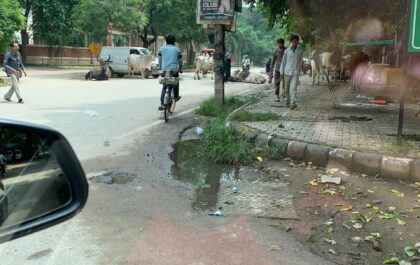Book Club
Nandita Haksar presented her book, The Colours of Nationalism, to a hushed audience. Everyone in the book club listened with rapt attention to the revelations about her life. As a writer and a human rights activist, she has maintained vigil for the oppressed across the country. She has been involved with the movements for self -determination in Kashmir as well as the Northeast even as she has represented victims of state violence as a lawyer during riots and massacres, tribals and unorganised workers, public sector employees, and migrant workers across the country.
As a journalist, she has been attached to the Indian Express. And during the early stages, she also worked for a British paper, The Times Education Supplement. As she recounts: I had to call my news editor by her first name required some adjustment. There was no Mrs or Miss or even a Ms, and I could not add a respectful ‘ ji ‘ and call her Patricia- ji either. In India my news editor was Mr Saxena, and later, when we had a more personal relationship, Piloo Saheb. ‘Pat‘ just felt wrong.
The second culture shock, she tells us, was the toilet paper in our bathrooms. On individual pieces it was printed: ‘ Now please wash your hands‘: Did the English have to be reminded of that?
A common issue among NGOs is whether they should accept foreign funds, Nandita says: Those of us who objected to accepting foreign funds were doing it from both a nationalist and a socialist perspective. We argued that these funds undermined Indian sovereignty as well as our socialist aspirations……….In more recent times the controversy has taken on entirely different dimensions, with the government of Prime Minister Modi amending the Foreign Contribution (Regulation) Act to provide for stricter requirements and regulations for NGOs receiving foreign funds.
In an interesting sidelight to the Khalistan movement, she observes: The supporters of Bhindranwale and the Khalastinis even tried to appropriate Bhagat Singh as a symbol of Sikh militancy. They put up a statue of the revolutionary wearing a turban in Ludhiana. Bibi Amrit Kaur went on a hunger strike and sat under the statue for days despite the heat. She was protesting the setting apart of Bhagat Singh from the Hindu comrades, Sukhdev and Rajguru. Bibi Amrit Kaur said she had three brothers, and she could not allow only one to be honoured when all three had gone to the gallows together. She eventually won her battle, and today Ludhiana boasts statues of all three martyrs.
During the discussion, Dr. Gautam Vohra, who is the author of 15 books on devel-opment and environment-related issues, said that he too had been actively involved in working for the poor and the marginalised through his NGO [now almost 40 years old]. He was keen to discover what gave Nandita Haksar greater satisfaction, her work as a writer or as an activist. She gave a detailed reply; the long and short of it was that both had their place. Among others who raised issues were Lekha Bhagat, Mira Gupta, Tarini Manchanda, Aruna Harprasad, Mira Chatterji, and Radhika Dubash.
Most of the questions related to challenges that the author faced. Activism would have constantly got her into conflict with the authorities. That could and on, lead to hardships if she was incarcerated. And having to travel all over as she was involved in a range of issues. On top of that, writing books gave no more than minimal money, how did she manage?
Nandita said by temperament she was what she was, and she obviously enjoyed what she was doing, and so far she had survived. What more could one ask for? On that optimistic note, the discussion came to a close.





























Popular Stories
Football Tournament @Princeton
More Than a Festival: The Art and Power of Durga Puja
Personality of the Month- ‘Dr Usha Mediratta’
Stray Cattle Menace In Front of Galleria
The Chronicles of Malibu Towne: A Mosquito’s Tale
“Senior Living Is Not An Old Age Home” say Mr & Mrs Bose
Recent Stories from Nearby
- A Story of Compassion January 28, 2025
- ‘The Power Of Imperfect Eating’ By Kavita Bhatnagar January 28, 2025
- New on the road January 28, 2025
- Khichdi Celebration January 28, 2025
- Canine Care January 28, 2025






